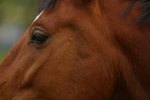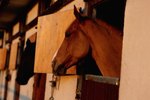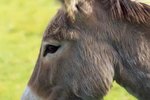It is an unfortunate fact, but flies appearing on hoofed stock is just about as common a problem as one can have when they own livestock. While there is no way to totally eradicate flies from landing on your donkeys or living where they are housed, there are methods that can be taken to control both their numbers and damage they can inflict on the animals.
Environmental Fly Control

One of the most important parts of controlling a fly population is to control what is in the donkey's environment. Flies are not only attracted to the donkeys but also to their manure, feed, rotting organic matter or garbage in the stable, field or corral areas. Keeping areas clean and free of moist hay or animal waste will help keep down the fly population. Fans can be placed to blow a downward and outward stream of air to keep flies from entering stables or barns. Box stalls, tack rooms and feed storage areas can benefit from screening to keep flies out of areas where they are likely to breed. Sticky fly strips should be hung and changed frequently enough that you can notice if the fly population is increasing. If it is, it might be a sign that housekeeping needs to be addressed.
Insecticides are appropriate when used properly. Pyrthrin-based insecticides are safe around animals when used according to manufacturer specifications. Pyrthroids are legal in most states, but check with your local authorities to be certain it is appropriate for use in your area.
Fly Repellents

Spray-on fly repellents that are approved for use on horses or donkeys can be sprayed on the donkey's legs where most flies tend to bite. Roll-on repellents are appropriate for use around the donkey's ears and eyes, taking caution not to get any in the eyes, nose or mouth. Apply according to manufacturer directions. Natural fly repellents are in the works but none have yet been approved for use by the U.S. Department of Agriculture.
Fly Masks and Leggings
Fly masks that are made for the specific needs of donkeys can be placed on the animal to cover the entire face to include ears. They do not have adverse effects on vision and most donkeys learn to tolerate the masks quickly. You can also purchase leggings made in part to keep biting flies at bay. These non-chemical solutions are effective for most animals when used in addition to fly repellent sprays gently applied to areas that are not covered by the mask and leggings.



